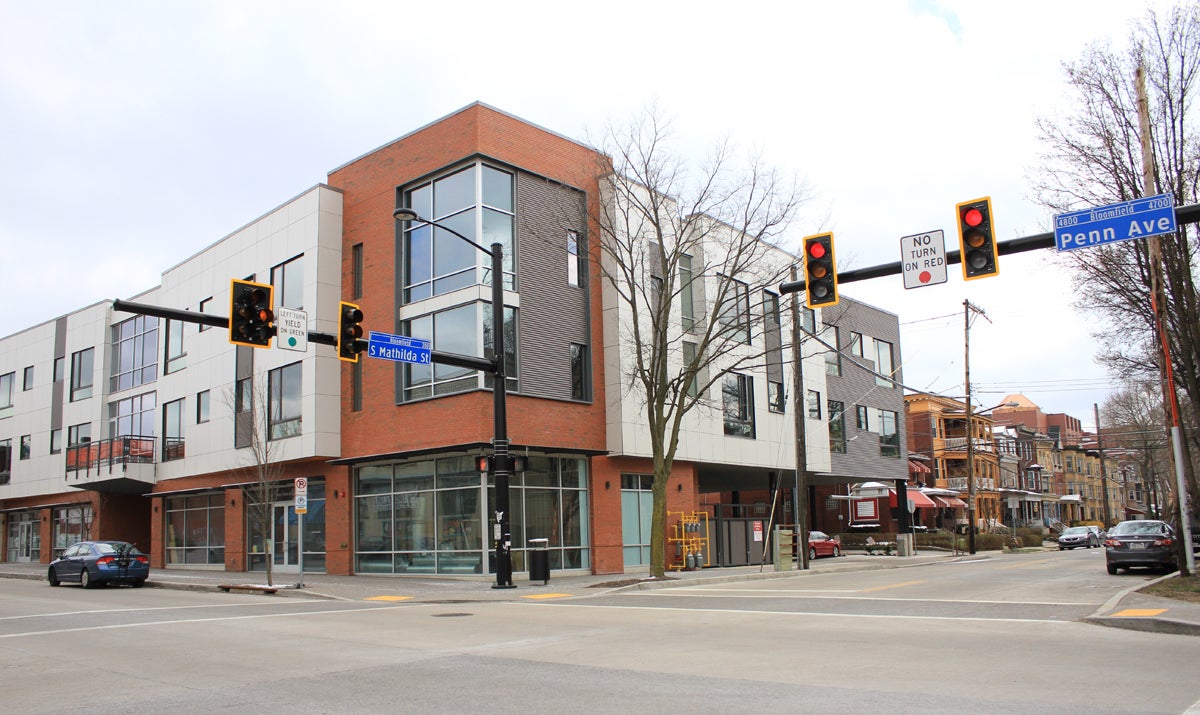Why every new Pa. apartment building doesn’t have to be a snowflake
Are Pittsburgh and Philadelphia in step with a national architectural trend or ceding too much of their vernacular style? Depends on who you ask.
Both Philadelphia and Pittsburgh are in the midst of multi-year building booms. More than 4,000 apartment units were built in the two cities last year.
For many years in Pittsburgh, new apartment buildings weren’t a priority: the city had plenty of available housing stock and, despite a steady flow of college students, fairly pedestrian demand. But in 2012, 958 new units were built. The next year, that number jumped to 3,227 and hasn’t fallen below 2,100 since, according to Jeff Burd, president of Tall Timber Group, an information service for the construction industry.
Like a brand new car in a high school parking lot, these freshly-minted buildings stick out: glimmering low-rises composed of neutral panels and glass, accented with corrugated metal, or brick, or a block of primary color. I couldn’t shake the question: Why do they look so similar? How did these materials and styles become the design du jour?
Thankfully, a few architects — and a bunch of thoughtful people on Reddit — were willing to entertain the question.
Architecture is a polyglot; it speaks multiple languages, said Christine Mondor, principal at evolveEA, and chair of the Planning Commission for the City of Pittsburgh. In a sense, the city’s newer apartment buildings are in conversation with one another.
“They’re all built fairly recently, they all share a similar building technology or at least are close to it. The first floor and maybe second floor are steel, and then it’s wood frame construction above.”
Furthermore, many of the new buildings are mixed-use, so the repetition of first floor commercial space paired with residential units above contributes to that, said Andrew Moss, owner and president of Moss Architects, which designed the Penn Mathilda apartments in the Pittsburgh neighborhood of Garfield.
“You see a lot of it in low-rise residential buildings like this, steel frame and wood framing, and that’s part of the building code. The building code requires a separation between your commercial on the ground floor and your residential upstairs.”
But new technology plays a role, too. The building industry changes more slowly than other industries, Moss said, and for a couple centuries, the materials available were pretty standard: stone, brick, wood, glass. And then along came the panel. A myriad of panel systems provide options for durable, lightweight construction that’s more flexible. European architects and developers have been using panels for a while — one company has manufactured cement facade panels since the 1950s — and they’ve finally made their way to the U.S.
“This material gives you a little bit more latitude as to how you choose to design your building face,” said Moss. “So it gives you a little bit more opportunity for creativity as to how you compose the facade.”
It could be about money, said David Schaaf, director of urban design for Philadelphia’s city planning commission.
“There’s a measure of economy that can be realized by using panels in a creative way with materials that are more traditional and more urbane: brick, stone, or cast stone,” he said. “Ideally, [they’re] used with other materials.”
As much as an architect or a planning commission might like to see buildings wrapped all in brick or stone, cost is a restraint, said Mondor.
“All those buildings have a budget they’re trying to hit, and that dictates what the cost per square foot can be. You have to understand the economics: is the owner holding on to it? Or is the owner selling it? They may need to recoup their costs. If it’s the difference between a building and no building?” She let the question hang in the air.
But Burd wondered if the real reason for the similarity between new buildings could be explained not by budgets or aesthetics, but a misunderstanding about what’s making people move in.
“I think it’s just a case of people adopting each other’s best practices, seeing what’s working and equating success with the design,” he said. But there’s “this explosion of amenities and amenity spaces. You know, the multiple living room kind of areas, the exercise room. I think if all these buildings were built with brick, and the same amenities, I think you’d see the exact same lease-up.”
A new building era
Across the country, there’s plenty of vitriol for this kind of construction: a Facebook group called Denver FUGLY takes aim at apartment buildings there; stories from Minneapolis, Minn. and Charlotte, S.C. wonder why all the new construction looks “the same.” But when I posed a similarly phrased question on Reddit — about whether or not Pittsburgh’s new apartment construction looks “too similar”— some questioned the value of decrying the new buildings.
Someone pointed out that most buildings belong to eras, and therefore tend to look alike; there are plenty of cherished buildings in Pittsburgh that share an aesthetic. Row houses, to take just one example. Someone else noted the restrictions of cost, and that new buildings may be a welcome change in neighborhoods struggling with vacancy or blight.
Jonathon Denson is a social worker, and created a blog called Discovering Historic Pittsburgh, where he documents older buildings “before they are gone.” He can’t shake the feeling that these modern buildings come at the expense of old ones. “And at the expense of residents, too,” he added, noting that the new apartments are often rented at prices beyond the reach of those who make even the city’s median income.
While there are more new apartments, there’s a dearth of new renters. Many older buildings are experiencing higher vacancy rates as people simply shift from one building to another.
Denson said he doesn’t hate the shared sleek, minimalist, modern look of the buildings going up, it’s just not his preferred aesthetic.
“I feel like there’s not enough Pittsburgh style or character in what they’re building now.”
Architects are influenced by what they see, said Moss, and the world wide web has fundamentally changed what’s available to look at.
“We know almost as much what’s going on in Pittsburgh as we do all over the world. And the downside to that is you’ve got a little less of the language of that particular city.” He paused, looking at a photo of Penn Mathilda on an iPad. “Maybe we didn’t do a good enough job.”
 The Penn Mathilda apartments in Garfield were designed by Moss Architects. (Margaret Krauss/WESA)
The Penn Mathilda apartments in Garfield were designed by Moss Architects. (Margaret Krauss/WESA)
But Mondor sees beauty in a building that fits in, nestling into the already-existing context of a street or neighborhood.
“Not every building wants to be a standout,” she said. “It’s because we have background buildings that those [standout] buildings can shine. If every building is completely different, then we don’t have a sense of the exceptional things.”
Architecture is always a compromise, said Mondor. “You’re always working with things that may be in conflict: your intentions, your budget, your context, your goals. It’s that conflict that makes the energy and makes good architecture when it all comes out right.”
Ultimately, a city’s architecture tells many stories, she said, and what you think depends on what you choose to look at.
WHYY is your source for fact-based, in-depth journalism and information. As a nonprofit organization, we rely on financial support from readers like you. Please give today.











